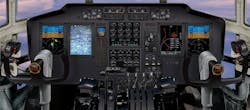Military avionics trends: cockpit upgrades, embedded computing, AESA radar, integration with civil airspace
WASHINGTON – In the coming years, the military avionics supply and demand chain will feature advanced cockpit upgrades and integration capabilities with civil airspace, as countries move forward on urban air mobility concepts and as the use of drones becomes increasingly common. Avionics International reports. Continue reading original article
The Military & Aerospace Electronics take:
10 Nov. 2020 -- Behind increasingly advanced touch-screen military cockpits that fuse information from a variety of sensors, lie required encryption technologies, more powerful embedded computing processor hardware, and networking technologies. That’s where Curtiss Wright Defense Solutions steps in as a subcontractor to Tier I suppliers, such as Raytheon, Lockheed Martin, and Honeywell.
Radar systems on military aircraft have been moving since the 1990s from mechanically steered antenna models to jam-resistant electronically scanned antenna systems that can track several different targets simultaneously.
In January, Northrop Grumman said the U.S. Air Force had completed the installation of the company’s AN/APG-83 Scalable Agile Beam Radar (SABR) active electronically scanned array (AESA) radar on Lockheed Martin F-16 Air National Guard jet fighters.
Related: The shrinking world of small-form-factor embedded computing
John Keller, chief editor
Military & Aerospace Electronics
